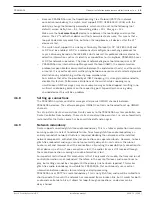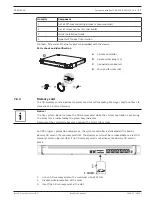
42
en | System composition
PRAESENSA
2019.11 | V1.00 |
Installation manual
Bosch Security Systems B.V.
All devices are connected in a single loop, which means that all devices have two ports in
active use for loop‑through cabling. The PRA-CSLD is used as emergency call station and has
three extensions connected. Because this is a voice alarm system, supervision is enabled.
Furthermore the system is specified to run from a battery for 24 hours in quiescent mode and
30 minutes in alarm mode.
Manufacturers specify the capacity of a lead‑acid battery at a specified discharge rate.
Typically the specified (nominal) battery capacity is based on fully discharging the battery in
20
hours with a constant (nominal) current. If the battery is discharged at a faster rate, the
delivered capacity is less, and if the battery is discharged at a slower rate the delivered
capacity is more. This effect is described by Peukert’s law. Without going into detail, this law
describes an exponential relationship between the discharge current and the delivered
capacity over a specified range of discharge currents. For flooded lead-acid batteries this
effect is very significant, for VRLA batteries this effect is much smaller but certainly not
negligible.
Consider a PRAESENSA system with a battery capacity that is sufficient for 24
h operation in
quiescent mode, followed by 0.5
h operation in alarm mode. In quiescent mode the discharge
current will be around half of the nominal current and a typical VRLA battery then has an
effective capacity of 110% of the nominal capacity. But during alarm mode the discharge
current can be up to ten times higher than the nominal discharge current and the effective
battery capacity then reduces to 75% of the nominal capacity. The consequence of this is that
the required nominal battery capacity should be around 20% higher than calculated without
taking Peukert’s law into account.
Because another 10% additional battery capacity is needed to compensate for aging and low
temperature operation, the battery must be oversized by approximately 30%.
5.4.5
Quick battery size calculation
A very simple and quick way to calculate the required battery capacity is to add up the
Ah‑values from the table below. This includes 30% battery oversize and it doesn’t matter
whether the amplifiers are 4‑channel or 8‑channel amplifiers, how many channels are in use or
what the loudspeaker load is, nor how many call station extensions are used, whether it is
used to make alarm calls or not, nor how many Ethernet ports are used. These details have
only a relatively small impact on the ultimate battery capacity needed and the Ah-values are
rounded up to include them all.
Device
Battery requirement
24
h qui 0.5
h alarm
30
h qui 0.5
h alarm
System controller
17 Ah
21 Ah
Call station with extensions
21 Ah
26 Ah
Amplifier
40 Ah
47 Ah
Multifunction power supply
21 Ah
25 Ah
According to this simple table, the system described in the previous section would get a
backup battery of 17 + 21 + 40 + 40 + 40 + 21
Ah = 179
Ah when used for 24
h in quiescent
condition and 30 minutes in alarm condition. The accurate calculation resulted in 170
Ah. The
additional benefit of this approach is that relatively small system changes, such as adding load
to an amplifier, can easily be made without changing the already installed battery capacity.
Summary of Contents for PRAESENSA
Page 1: ...PRAESENSA Public Address and Voice Alarm System en Installation manual ...
Page 2: ......
Page 193: ......






























